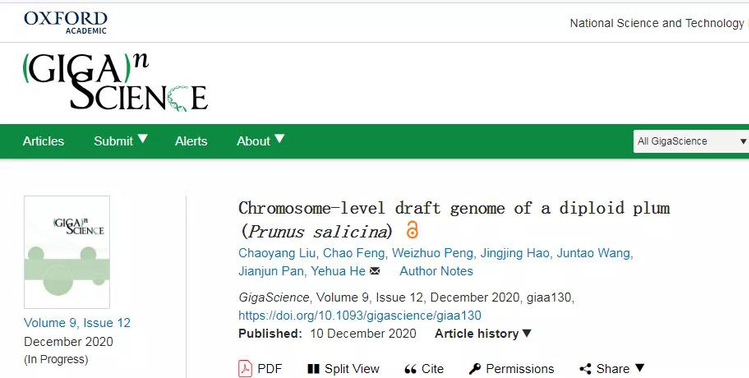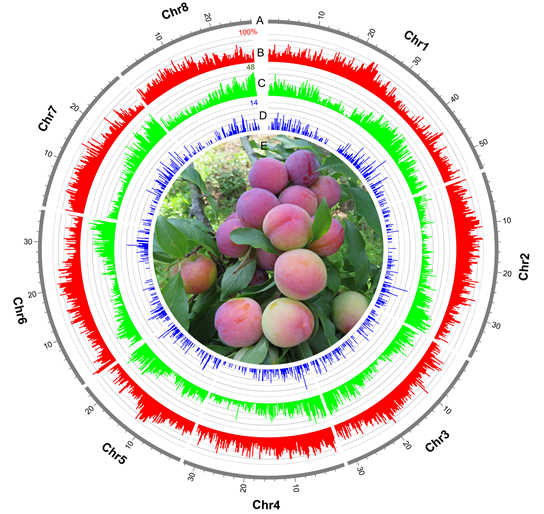
South China Agricultural University releases the first chromosome-level high-quality Chinese plum genome
Recently, the plum germplasm resources and genetic breeding research team led by Professor He Yehua from the College of Horticulture, South China Agricultural University, officially released the chromosome-level high-quality Chinese plum genome map for the first time, with the title The chromosome-level draft genome of a diploid plum (Prunus salicina) )” The related research results were published in Gigascience on December 10, 2020.

Plum is one of the oldest fruit trees with the longest cultivation history in my country. There are 19-40 plum species in the world, some of which are interspecific hybrids, and there is a richer diversity that other fruit trees do not have. The lack of plum genome information has seriously hindered the excavation and utilization of excellent plum germplasm resources and the mechanism analysis and genetic improvement of plum important traits. The research team used PacBio and Illumina sequencing and Hi-C technology to assemble the Chinese plum genome with a size of about 284.2 Mb, of which 274.4 Mb sequence is anchored on 8 chromosomes, scaffold N50 is 32.3Mb, contig N50 is 1.8Mb , BUSCO analysis result is 95.70%. Repetitive sequences accounted for 48.3% of the genome, and 23,931 protein-coding genes were annotated. Based on estimates of the phylogeny and differentiation time of single-copy genes, it was found that Chinese plums are closely related to plums and apricots, and separated from their nearest common ancestor about 9.05 million years ago.

Gene family expansion and contraction analysis found that a DUF579 gene family that controls xylan biosynthesis has a significant expansion in Chinese plums, which is consistent with the feature that plums have more xylan compound accumulation than other stone fruits. This provides a new way of thinking and direction for the study of metabolism regulation of xylan compounds in Prunus. In addition, the FRS gene family, which is widely involved in various processes of plant growth and development, has also been found to have a significant expansion in Chinese plums, which may be related to the extensive adaptability of Chinese plums.
South China is the main plum producing area in my country, and the plum has formed a unique group of South China plum varieties here, which has the characteristics of less cold demand and early ripening season. The Li research team of South China Agricultural University has persisted in the collection, preservation, evaluation and identification of plum germplasm resources for many years, and has presided over the selection and breeding of 7 high-quality, high-yield plums including'Congzao No. 1 Zao Li' and'Yunkai No. 1 Sanhua Li'. , Excellent new plum varieties with strong stress resistance, developed a complete set of high-quality and high-yield cultivation techniques unique to South China. The sequencing material used in this study is the plum variety'Sanyue Li', which is widely cultivated in South China and has the lowest cold requirement among the known Chinese plum germplasms. The genome map is completed, and the cold requirement of plums is required. The genetic improvement of important agronomic traits and the cultivation of new varieties have laid an important foundation. At present, all the genome data of Chinese plums measured by the team have been uploaded to multiple public databases such as GigaDB, NCBI, GDR and Figshare, and all permissions have been opened for sharing and use by global researchers and breeders.
Professor Yehua He from the College of Horticulture of South China Agricultural University is the corresponding author of the paper. Dr. Chaoyang Liu from the College of Horticulture of South China Agricultural University and Dr. Chao Feng from the South China Botanical Garden of the Chinese Academy of Sciences are the co-first authors of the paper. This research is jointly supported by the Guangzhou Science and Technology Development and Innovation Key Project (201704020021) and the Guangdong Province Modern Agricultural Industrial Technology System Project.


